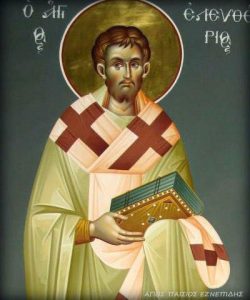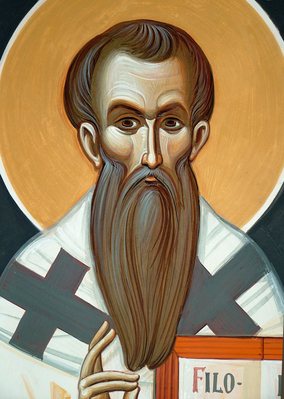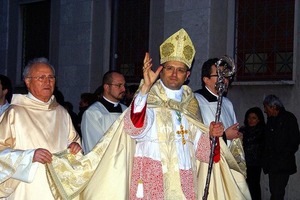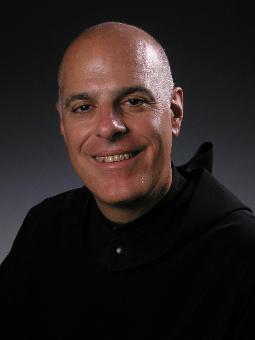 Today is the feast of Saint Hilarion “the Great” of Gaza, “Father of Palestinian Monasticism”: Syro-Roman rhetorician, convert from paganism, Antonian monk of Pispir, desert- and cave-dwelling hermit, mystic, and wonderworker—who died at Paphos in 371, at about 80 years old.
Today is the feast of Saint Hilarion “the Great” of Gaza, “Father of Palestinian Monasticism”: Syro-Roman rhetorician, convert from paganism, Antonian monk of Pispir, desert- and cave-dwelling hermit, mystic, and wonderworker—who died at Paphos in 371, at about 80 years old.
Tag: monasticism
Hesychia: necessary for monk and lay person
Throughout the history of Eastern monasticism, there has always been an understanding of silence and solitude that has been called “hesychia”. Hesychia refers to a state of inner stillness and stability that is increasingly able to discern the presence of God in the length and breadth of the everyday. It involves an attitude of listening that focuses the heart, regardless of what one happens to be doing. But the truth is, such silence does not come cheap. It requires practice, a type of spiritual practice that leads one through many levels of growth. This has its analogy in athletic practice, where to reach excellence demands self-sacrifice, personal commitment, making mistakes, and hours and hours of work. (thanks to NS)
St Pachomius the Great
 Our venerable father among the saints, Pachomius, the great, is liturgically commemorated. He is a central figure in the monastic life, East and West.
Our venerable father among the saints, Pachomius, the great, is liturgically commemorated. He is a central figure in the monastic life, East and West.
Pachomius was born in 292. As a young man, he served in the army under the emperor Constantine. The hardship of military life in Egypt was lightened by the kindness the soldiers encountered in every Christian settlement along their march. Pachomius was so impressed that he was baptized and embraced the monastic life.
He withdrew to the Egyptian wilds to live with Palemon, one of the desert fathers. After his guide and teacher died, Pachomius’ brother John came to live with him. Before long there were others, and Pachomius was soon the abba of a whole colony of monastics, totaling about seven thousand. His gift of leadership and skill in organization has been raised by later tradition to the level of direct divine inspiration, which is expressed in the story of an angel, dressed in the monastic habit, appearing to Pachomius and instructing him to adopt this garb for his monks. Aside from such embellishments, Pachomius remained a model of practical genius.
He established the Lavra of Tabenna on the Nile, with a school for boys and a hospice for travelers. He wrote a typicon in Coptic, probably the first such rule in monastic history, and insisted that all the monks learn to read the scriptures. He organized teams of cooks, bakers, and gardeners. Each dwelling for these professional families included a library and a scriptorium for the copying of sacred texts.
His sister begged him to start a monastery for women. Her persistence and the number of nuns already at the gates moved him to consent. It was built on the opposite bank of the Nile. Twenty years after the council of Nicaea, a plague swept through the Nile valley. Pachomius died nursing his stricken monks.
(NS typicon)
The Orthodox and Catholic Churches remember him today, May 15th while the Coptic Church celebrates his feast on May 9th.
St. Eleutherius the Abbot
I have a very vague recollection of today’s saint, Eleutherius, from some travels in Italy. A friend posted this sketch of a 6th century monk. Just to situate him: St Benedict died in 547. Some recent theological discussion in the Communio Study Circle about angels and demons leads me think more deeply about persons like Eleutherius.
St. Eleutherius (d. 585 A.D.) was a monk living in Spoleto, Italy. Little is known of his early life. He became the Abbot of St. Mark’s Abbey and was well-known as a man of simplicity and penance. He also demonstrated the gift of miracles and exorcism, and raised a dead man to life. After he healed a boy from demonic possession and saw that the child was afterwards left unharmed, St. Eleutherius made a remark to this effect: “Since the child is among the servants of God, the devil dares not approach him.”
Then the boy, who came to live at St. Mark’s Abbey to be educated by the monks, became possessed again. St. Eleutherius repented of his vain and presumptuous remark, and the whole monastery underwent a penitential fast before the devil would leave the boy for the final time. St. Eleutherius was a friend of Pope St. Gregory the Great, the latter having called upon the saint to pray for him in his illness. St. Eleutherius died in Rome in 585 A.D. Today is his feast day. (DG)
St Aidan
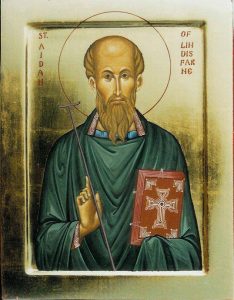 I doubt many people know much about Saint Aidan except surface level stuff. The name “Aidan” is a beautiful name and it carries with it the beauty of the best of Catholicism in Ireland and parts of England and Wales. Saint Aidan was seeking someone great –he was truly seeking God. This seeking is the principle, the grammar by which we truly live the Faith.
I doubt many people know much about Saint Aidan except surface level stuff. The name “Aidan” is a beautiful name and it carries with it the beauty of the best of Catholicism in Ireland and parts of England and Wales. Saint Aidan was seeking someone great –he was truly seeking God. This seeking is the principle, the grammar by which we truly live the Faith.
“Monastic founder, bishop, and miracle worker known for his kindness to animals. Known as Edan, Modoc, and Maedoc in some records, Saint Aidan was born in Connaught, Ireland. His birth was heralded by signs and omens, and he showed evidence of piety as a small child. Educated at Leinster, Saint Aidan went to Saint David monastery in Wales. He remained there for several years, studying Scriptures, and his presence saved Saint David from disaster. Saxon war parties attacked the monastery during Saint Aidan’s stay, and he repelled them miraculously. In time, Saint Aidan returned to Ireland, founding a monastery in Ferns, in Wexford. He became the bishop of the region as well. His miracles brought many to the Church. Saint Aidan is represented in religious art with a stag. He made a beautiful stag invisible to save it from hounds.”
Saint Aidan, pray for Us!
Saint John Paul II
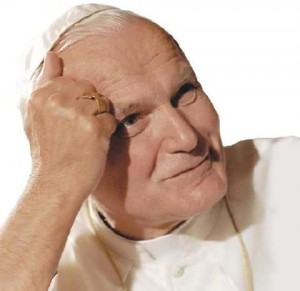 Blessed Feast of Pope Saint John Paul II!
Blessed Feast of Pope Saint John Paul II!
Saint John Paul II: “In its present form, inspired above all by Saint Benedict, Western monasticism is the heir of the great number of men and women who, leaving behind life in the world, sought God and dedicated themselves to him, “preferring nothing to the love of Christ”.The monks of today likewise strive to create a harmonious balance between the interior life and work in the evangelical commitment to conversion of life, obedience and stability, and in persevering dedication to meditation on God’s word (lectio divina), the celebration of the Liturgy and prayer.”
–Vita Consecrata, 6
Saint Anthony of Egypt
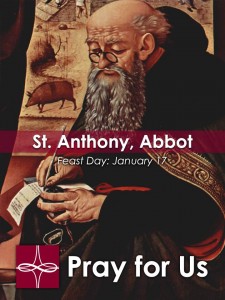 Today, the Church recalls the memory of Saint Antony, Abbot (251-356) ~ “Father of Monasticism”! The saint was born in Egypt: he listened to and then followed the words of the Gospel and gave all his material things to the poor. Anthony left civilization as it was known then and went into the wilderness to begin a life of penitence, living in absolute poverty, praying, meditating, and supporting himself by manual work. He suffered many temptations, both physical and spiritual, but he overcame them. As you would expect, disciples found his manner of life and teaching attractive: his wisdom, love, moderation, and holiness. He gave support to the victims of the persecutions of Diocletian, and helping Saint Athanasius in his fight against the Arians. He lived to be over a hundred years old.
Today, the Church recalls the memory of Saint Antony, Abbot (251-356) ~ “Father of Monasticism”! The saint was born in Egypt: he listened to and then followed the words of the Gospel and gave all his material things to the poor. Anthony left civilization as it was known then and went into the wilderness to begin a life of penitence, living in absolute poverty, praying, meditating, and supporting himself by manual work. He suffered many temptations, both physical and spiritual, but he overcame them. As you would expect, disciples found his manner of life and teaching attractive: his wisdom, love, moderation, and holiness. He gave support to the victims of the persecutions of Diocletian, and helping Saint Athanasius in his fight against the Arians. He lived to be over a hundred years old.
Saint Anthony of the Desert taught,
“One should not say that it is impossible to reach a virtuous life; but one should say that it is not easy. Nor do those who have reached it find it easy to maintain. Those who are devout and whose intellect enjoys the love of God participate in the life of virtue; the ordinary intellect, however, is worldly and wavering, producing both good and evil thoughts, because it is changeful by nature and directed towards material things. But the intellect that enjoys the love of God punishes the evil which arises spontaneously because of man’s laziness.”
Saint Basil the Great
Since it is impossible to be saved unless we perform our works in accordance with the commandment of God, and since we disregard none of the commandments without peril — for it is a terrible arrogance to set ourselves up as the critics of our Lawgiver, now approving some of his laws, now dismissing others — let us who are combatants for piety and who esteem the life of tranquility and freedom from affairs as our collaborator in the keeping of the Gospel decrees, set before ourselves a common mind and purpose: that not so much of a single one of the commandments escape us. For if the man of God must be perfect — as it is written and as our earlier discourse on these matters has shown — it is entirely necessary that he be pruned. (cf. John 15:1) by every one of the commandments unto the measure of the stature of the fullness of Christ (Eph. 4:13); for according to the divine law a beast with a blemish even though clean, was unacceptable as a sacrifice to God (cf. Lev. 21. 19-20).
Saint Basil (329/30-379) was the bishop in what is modern Turkey in a city called Casesarea Mazaca in Cappadocia. Basil was attentive the needs of the poor and he is famous for for us rule for monasteries that focussed on the common life, the sacred liturgy and manual labor. Saint Benedict used Basil’s rule as one of a few for his own rule for monasteries. Basil is called the “revealer of heavenly mysteries.” Together with Gregory of Nyssa and Gregory of Nazianzus is known as the Cappadocian Fathers. Saint Basil was a firm supporter of the Nicene Creed and fought heresy.
Let’s pray for hospital administrators today through the intercession of Saint Basil.
Pietro Vittorelli, OSB, resigns abbacy of Montecassino
It’s finally been decided: Abbot Pietro Vittorelli has resigned the abbacy and his ministry of Ordinary of Cassino. Pope Francis invoked the Code of Canon Law 401.2 regarding matters of health.
Last year I asked readers of Communio to pray for Abbot Pietro here.
He now needs to pay more attention to his health for his own good, that of the monastic community that he intensely loves but also for the diocesan community.
Until the monastic community of Montecassino can be called together to elect a new abbot, the Prior of Sacro Speco at the Abbey of Saint Scholastica (on Subiaco) and the Director of the Library in the City there, Dom Augusto Ricci will serve as the Apostolic Administrator.
Dom Pietro was born on 30 June 1962, professed of vows in 1991, ordained priest in 1994, elected and confirmed in the abbatial office and Diocesan Ordinary of Montecassino in 2007. The great abbey of Montecassino is a territorial abbey. The stats of the diocese in 2004 state that there were 79,000 souls, with 68 priests (secular and religious) serving in 53 parishes.
From the Italian media.
Through the intercession of Blessed Columba Marmion we pray,
O God, Almighty Father, who, having called the blessed abbot Columba to the priesthood and to the monastic way of life, wonderfully opened to him the secrets of the mysteries of Christ, grant, in Thy goodness, that, strengthened by his teachings in the spirit of our adoption as Thy sons, we may pray to Thee with a boundless confidence, and so obtain, through his intercession, the full restoration to health of Dom Pietro Vittorelli, Abbot of Monte Cassino. We ask this grace for the joy of Thy Church, for the consolation of the community of Monte Cassino, and for the praise of Thy glory, through our Lord Jesus Christ, Thy Son, who liveth and reigneth with Thee, in the unity of the Holy Spirit, one God forever and ever. Amen.
New York-native Benedictine monk illuminates the Word
Pope Paul VI told us we need more witnesses to the faith. I’ve quoted the pope several times on this just point. True, the personal witness of a man and woman to the inner and outer works of the Holy Spirit is what concretely moves the heart. Truth is encountered in the witness. Father Tom Rosica, CSB, of Salt and Light TV interviews known and less known witnesses of the faith that for me, really opens new vistas.
Continue reading New York-native Benedictine monk illuminates the Word
